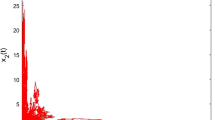Abstract
We investigate a stochastic model for the competition between two species. Based on percentiles of the maximum number of individuals in the ecosystem, we present an approximating model for which the extinction time can be thought of as a phase-type random variable. We determine formulae for the probabilities of extinction and the moments of the extinction time. We discuss the use of several quasi-stationary assumptions. We include a comparative study between existing asymptotic results, results obtained from a simulation of the process, and our solution.
Similar content being viewed by others
References
Allen EJ (1999) Stochastic differential equations and persistence time for two interacting populations. Dyn Contin Discret Impuls Syst 5: 271–281
Allen LJS (2003) An introduction to stochastic processes with applications to biology. Pearson Education, New Jersey
Bailey NTJ (1964) The elements of stochastic processes. Wiley, New York
Ballyk MM, Wolkowicz GSK (2010) Classical and resource-based competition: a unifying graphical approach. J Math Biol. doi:10.1007/s00285-010-0328-x
Barbour AD (1976) Quasi-stationary distributions in Markov population processes. Adv Appl Probab 8: 296–314
Bartlett MS (1956) Deterministic and stochastic models for recurrent epidemics. In: Neyman J (ed) Proceedings of the 3rd Berkeley symposium on mathematical statistics and probability, vol IV: Contributions to biology and problems of health. University of California Press, Berkeley, pp 81–109
Bartlett MS (1960) Stochastic population models in ecology and epidemiology. Wiley, New York
Bean NG, Bright L, Latouche G, Pearce CEM, Pollett PK, Taylor PG (1997) The quasi-stationary behavior of quasi-birth-and-death processes. Ann Appl Probab 7: 134–155
Bean NG, Pollett PK, Taylor PG (2000) Quasistationary distributions for level-dependent quasi-birth-and-death processes. Stoch Model 16: 511–541
Billard L (1974) Competition between two species. Stoch Process Their Appl 2: 391–398
Brockwell PJ (1985) The extinction time of a birth, death and catastrophe process and of a related diffusion model. Adv Appl Probab 17: 42–52
Chung KL (1960) Markov chains with stationary transition probabilities. Springer, Berlin
Cushing JM (1980) Two species competition in a periodic environment. J Math Biol 10: 385–400
Darroch JN, Seneta E (1965) On quasi-stationary distributions in absorbing discrete-time finite Markov chains. J Appl Probab 2: 88–100
Darroch JN, Seneta E (1967) On quasi-stationary distributions in absorbing continuous-time finite Markov chains. J Appl Probab 4: 192–196
Ellner S (1989) Convergence to stationary distributions in two-species stochastic competition models. J Math Biol 27: 451–462
Gyllenberg M, Silvestrov DS (1994) Quasi-stationary distributions of a stochastic metapopulation model. J Math Biol 33: 35–70
Gyllenberg M, Silvestrov DS (2008) Quasi-stationary phenomena in nonlinearly perturbed stochastic systems. Walter de Gruyter GmbH & Co. KG, Berlin
Hsu SB (1981) On a resource based ecological competition model with interference. J Math Biol 12: 45–52
Iglehart DL (1964) Multivariate competition processes. Ann Math Stat 35: 350–361
Kemeny JG, Snell JL (1961) Potentials for denumerable Markov chains. J Math Anal Appl 6: 196–260
Kijima M (1997) Markov processes for stochastic modelling. Chapman & Hall, London
Lamperti J (1963) Criteria for stochastic processes. II. Passage-time moments. J Math Anal Appl 7: 127–145
Li B, Smith HL (2007) Global dynamics of microbial competition for two resources with internal storage. J Math Biol 55: 481–515
Lotka AJ (1925) Elements of physical biology. Williams & Wilkins, Baltimore
Neuts MF (1994) Matrix-geometric solutions in stochastic models: an algorithmic approach, 2nd edn. Dover Publications, New York
Nisbet RM, Gurney WSC (1982) Modelling fluctuating populations. Wiley, New York
Norris JR (2004) Markov chains. Cambridge University Press, Cambridge
Pakes AG (1987) Limit theorems for the population size of a birth and death process allowing catastrophes. J Math Biol 25: 307–325
Pakes AG (1988) The supercritical birth, death and catastrophe process: limit theorems on the set of non-extinction. J Math Biol 26: 405–420
Pakes AG (1989) A complementary note on the supercritical birth, death and catastrophe process. J Math Biol 27: 321–325
Pakes AG, Pollett PK (1989) The supercritical birth, death and catastrophe process: limit theorems on the set of extinction. Stoch Process Their Appl 32: 161–170
Pielou EC (1969) An introduction to mathematical ecology. Wiley-Interscience, New York
Pitman JW (1977) Occupation measures for Markov chains. Adv Appl Probab 9: 69–86
Renshaw E (1991) Modelling biological populations in space and time. Cambridge University Press, Cambridge
Reuter GEH (1961) Competition processes. In: Neyman J (ed) Proceedings of the 4th Berkeley symposium on mathematical statistics and probability, vol II: Contributions to probability theory. University of California Press, Berkeley, pp 421–430
Ridler-Rowe CJ (1978) On competition between two species. J Appl Probab 15: 457–465
Roozen H (1987) Equilibrium and extinction in stochastic population dynamics. Bull Math Biol 49: 671–696
Shi DH, Guo J, Liu L (1996) SPH-Distributions and the rectangle-iterative algorithm. In: Chakravarthy SR, Alfa AS (eds) Matrix-analytic methods in stochastic models. Lecture notes in pure and applied mathematics, vol 183. Marcel Dekker, Inc., New York, pp 207–224
Silvestrov DS (1996) Recurrence relations for generalized hitting times for semi-Markov processes. Ann Appl Probab 6: 617–649
Tilman D (1982) Resource competition and community structure. Princeton University Press, New Jersey
Volterra V (1931) Leçons sur la théorie mathématique de la lutte pour la vie. Gauthier-Villars, Paris
Walker DM (1998) The expected time until absorption when absorption is not certain. J Appl Probab 35: 812–823
Author information
Authors and Affiliations
Corresponding author
Rights and permissions
About this article
Cite this article
Gómez-Corral, A., López García, M. Extinction times and size of the surviving species in a two-species competition process. J. Math. Biol. 64, 255–289 (2012). https://doi.org/10.1007/s00285-011-0414-8
Received:
Revised:
Published:
Issue Date:
DOI: https://doi.org/10.1007/s00285-011-0414-8




